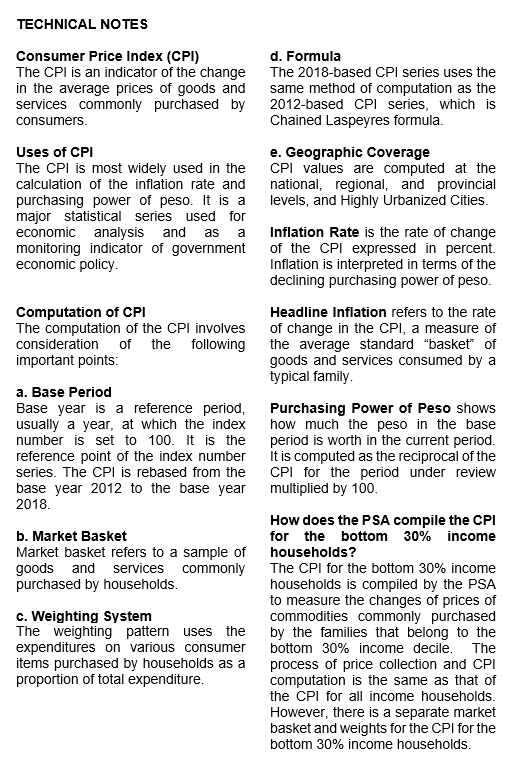

1. Regional Headline Inflation
The Davao Region’s inflation rate for the bottom 30% income households accelerated to 5.4 percent in February 2024 from 3.9 percent in January 2024. In February 2023, the region’s inflation was higher at 12.1 percent. (Table 1 and Figure 1).
The uptrend in the region’s overall inflation for the bottom 30% income households in February 2024 was primarily due to the faster annual growth in the index of Food and Non-Alcoholic Beverages at 10.2 percent from 8.3 percent in the previous month. Additionally, the faster annual increments of Housing, Water, Electricity, Gas, and other Fuels at -10.6 percent from -13.0 percent, Transport at 3.1 percent from 0.8 percent, Health at 2.5 percent from 2.2 percent, and Recreation, Sport, and Culture at 10.9 percent in the previous month contributed to the downward trend of the regional inflation for the bottom 30% income households. (Table 2)
Lower annual increments were noted in the indices of the following commodity groups during the month:
a. Alcoholic Beverages and Tobacco at 12.2 percent from 12.8 percent;
b. Furnishings, Household Equipment, and Routine Household Maintenance at 3.7 percent from 4.1 percent;
c. Information and Communication at -0.1 percent from 0.3 percent;
d. Restaurants and Accommodation Services at 7.9 percent from 8.6 percent; and
e. Personal Care, and Miscellaneous Goods and Services at 3.7 percent from 3.9 percent.
Meanwhile, the commodity groups of Clothing and Footwear at 5.4 percent, Education Services at 3.9 percent, and Financial Services at -0.1 percent retained their previous month’s inflation rates.

2. Davao Region Food Inflation
Food inflation for the bottom 30% income households at the regional level accelerated to 10.4 percent in February 2024 from 8.5 percent in the previous month. In February 2023, the Food inflation was posted at 12.6 percent. (Table 3)
The main driver in the increase of Food inflation in the region in February 2024 was Vegetables, Tubers, Plantains, Cooking Bananas, and Pulses at 1.0 percent from -10.7 percent in the previous month. The following food groups also recorded faster inflation compared to January 2024:
a. Fish and Other Seafood at 6.0 percent from 0.8 percent;
b. Cereals and Cereal Products at 22.7 percent from 21.6 percent;
c. Ready-Made Food and Other Food Products N.E.C. at 5.8 percent from 4.8 percent;
On the other hand, the price movement of the following groups moved slower compared to the previous month:
a. Meat and Other Parts of Slaughtered Land Animals at -1.4 percent from 0.1 percent;
b. Milk, Other Dairy Products, and Eggs at 5.9 percent from 8.4 percent;
c. Oils and Fats at -17.2 percent from -14.2 percent;
d. Fruits and Nuts at 25.5 percent from 28.9 percent; and
e. Sugar, Confectionery, and Desserts at -9.1 percent from -5.8 percent.

3. Regional Inflation Rates
At the national level, the country's inflation for the bottom 30% income households increased to 4.2 percent in February 2024, from 3.6 percent in the previous month. (Table 4)
Among the 17 administrative regions, Region III (Central Luzon) had the highest inflation at 6.1 percent followed by Region XII (SOCCSKSARGEN) at 5.8 percent and Region VIII (Eastern Visayas) and Region XI (Davao Region) both at 5.4 percent. On the other hand, Region II (Cagayan Valley) had the lowest inflation at 2.5 percent. (Table 4 and Figure 2)


Note: CPIs and inflation rates by province and selected city are posted on the PSA website (http://openstat.psa.gov.ph/).
APPROVED FOR RELEASE:
RANDOLPH ANTHONY B. GALES
(Chief Statistical Specialist)
Officer-In-Charge
Regional Statistical Services Office 11

